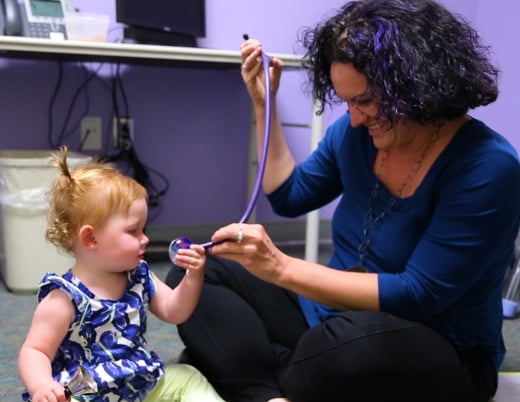Key takeaways
-
Researchers analyzed previous study data from girls 12 to 21 years old who had a body mass index above the 90th percentile and polycystic ovary syndrome.
-
They categorized study data by participant-identified race and ethnicity, and reviewed measurements of several characteristics related to metabolism.
-
They found racial differences in metabolic outcomes in girls with obesity or overweight and PCOS.
Research background: determining racial and ethnic differences among adolescent girls with PCOS
Polycystic ovary syndrome is a common condition in women and adolescent girls that can be caused by obesity or other factors. PCOS is linked to metabolic syndrome (MetS), a group of risk factors that can lead to reproductive dysfunction, insulin resistance, the development of dysglycemia or type 2 diabetes, and cardiovascular disease.
Metabolic disease varies by race and ethnicity in the general population, but there has not been extensive research to determine if PCOS-related metabolic disease in adolescent girls is affected by race and ethnicity. Researchers from the Department of Pediatric Endocrinology at Children’s Hospital Colorado wanted to better understand potential racial or ethnic differences, with the goal of developing targeted early prevention and treatment for this population. The study examined racial and ethnic differences in insulin sensitivity and metabolic symptom markers in adolescent girls with PCOS.
Research methods: a review of data from previous studies
Researchers performed a secondary analysis of previous study data from girls 12 to 21 years of age who had a body mass index above the 90th percentile as well as PCOS. The groups were categorized by race or ethnicity and data was collected from three previous cross-sectional studies with nearly identical enrollment requirements. A total of 101 participants enrolled in the studies between 2012 and 2018:

Researchers analyzed fasting hormones and metabolic measures, two-hour glucose tolerance tests and MRI results for hepatic fat.
Research results: the measurements that differed among the ethnicities of the study participants
The following measurements were found to be different among all participants:

Data are mean ± standard deviation or median (25th, 75th). * post-hoc p<0.05-0.01 compared to NHW participants, ** post-hoc p<0.01-0.001 compared to NHW participants *** post-hoc p<0.001 compared to NHW participants, ‡ post-hoc p<0.05-0.01 compared to HW participants, ‡‡ post-hoc p<0.01-0.001 compared to HW participants.
Measurements resulting in no differences or insignificant differences among the groups
- Characteristics: Age, BMI percentile and waist-to-hip ratios
- Measurements associated with PCOS: Free androgen index (FAI), free testosterone, hirsutism scores
- Measurements of liver inflammation, liver fat, body fat, lipid and glycemic parameters: Liver fat, AST, ALT post-hoc testing, body composition, total cholesterol, LDL-C concentrations
- Measurements of insulin sensitivity, secretion and clearance: Fasting, 2-hour OGTT glucose and insulin concentrations, Matsuda scores, fasting insulin clearance or insulin secretion as assessed by HOMA-%B
Measurements that stood out in one ethnicity over the others
- Hepatic markers of insulin resistance, including lower sex hormone binding globulin and higher triglyceride over high density lipoprotein cholesterol ratio (TG/HDL-C), were worse in non-Hispanic Whites (p=0.002 overall, HW vs. NHB [p=0.009] vs. NHW [p=0.020])
- HOMA-IR, was worst in non-Hispanic Blacks (p=0.010 overall, NHW vs. NHB p=0.014)
- HbA1c was lowest in non-Hispanic whites (overall p<0.001, NHW 5.2±0.3 vs. HW 5.5±0.3 p<0.001 vs. 5.7±0.4%, p<0.001)
Research conclusions: metabolic outcomes in girls with obesity and PCOS vary among race, ethnicity
In terms of the mechanisms of metabolic disease, adolescents with PCOS appear to show similar racial and ethnic variation as the general population. Study authors showed there are racial differences in metabolic outcomes in girls with obesity or overweight and PCOS.
While TG/HDL-C may be indicators for insulin resistance and metabolic syndrome in NHW and HW girls, this ratio is not a valuable indicator for NHB girls. NHB girls with obesity or overweight and PCOS are just as likely to have insulin resistance as HW girls. NHB girls are also known to be at higher risk for T2D than NHW girls and should be followed closely for development of T2D.
Featured Researchers
Melanie Cree, MD, PhD
Director, Multi-Disciplinary PCOS clinic
Department of Pediatric Endocrinology
Children's Hospital Colorado
Associate professor
Pediatrics-Endocrinology
University of Colorado School of Medicine

Megan Kelsey, MD
Medical Director of Lifestyle Medicine and of Adolescent Bariatric Surgery
Department of Pediatric Endocrinology
Children's Hospital Colorado
Professor
Pediatrics-Endocrinology
University of Colorado School of Medicine

Kristen Nadeau, MD, MS
Vice Chair for Clinical and Translational Research
Department of Pediatric Endocrinology
Children's Hospital Colorado
Professor
Pediatrics-Endocrinology
University of Colorado School of Medicine
Laura Pyle, PhD
Associate professor
Pediatrics-Endocrinology
University of Colorado School of Medicine





 720-777-0123
720-777-0123










